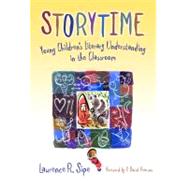
Note: Supplemental materials are not guaranteed with Rental or Used book purchases.
Purchase Benefits
What is included with this book?
| Foreword | p. ix |
| Acknowledgments | p. xiii |
| Introduction | p. 1 |
| Literary Understanding: A Neglected Part of the Literacy Landscape | p. 3 |
| The Marginalization of Reading Aloud to Young Children | p. 5 |
| Why Another Theory? | p. 8 |
| Audience | p. 9 |
| Picturebooks and Literary Understanding | p. 11 |
| Picturebooks and Children's Responses | p. 13 |
| Examining Picturebooks | p. 14 |
| Reading the Signs: Semiotic Perspectives | p. 16 |
| Perspectives from Visual Aesthetic Theory | p. 18 |
| The Relationship of Text and Pictures | p. 21 |
| Research on Children's Responses to Picturebooks | p. 28 |
| Young Children's Literary Understanding: Either Text or Reader | p. 36 |
| The Social Constructivist Paradigm and Vygotsky's Sociocultural Approach | p. 36 |
| Talk in the Classroom | p. 38 |
| Cognitive Perspectives on Children's Comprehension of Narratives | p. 40 |
| Literary Perspectives on Using Literature in the Classroom | p. 43 |
| Young Children's Literary Understanding: Between Text and Reader | p. 55 |
| The Middle Ground: Iser and Rosenblatt | p. 55 |
| Britton's Participant and Spectator Stances | p. 59 |
| Benton's Construct of the Secondary World | p. 61 |
| Langer's Model of Envisionment | p. 65 |
| Bogdan's Theory of Reader Stances | p. 66 |
| Can't We Just Enjoy Literature? The Theorization of Pleasure | p. 69 |
| Research About Literary Talk in the Classroom | p. 70 |
| Five Aspects of Literary Understanding and Their Interrelationships | p. 83 |
| Introducing the Categories of Response and the First Type of Analytical Response | p. 85 |
| The Categories of Children's Responses | p. 85 |
| Examples of the Live Conceptual Categories | p. 87 |
| Making Narrative Meaning | p. 90 |
| Other Types of Analytical Response | p. 111 |
| The Book as Made Object or Cultural Product | p. 111 |
| The Language of the Text | p. 115 |
| Analysis of Illustrations and Other Visual Matter | p. 117 |
| Relationships Between Fiction and Reality | p. 126 |
| Intertextual Responses: How Stories "Lean" on Stories (and Other Texts) | p. 131 |
| Three Types of Intertextual Connections | p. 131 |
| The Roles of Intertextual Connections | p. 136 |
| The Power of Text Sets | p. 147 |
| Intertextual Resistance to Stories | p. 150 |
| Personal Response: Drawing the Story to the Self | p. 152 |
| Life-to-Text Connections | p. 152 |
| Text-to-Life Connections | p. 160 |
| Other Personal Connections | p. 162 |
| Children's Personal Resistance to Stories | p. 166 |
| Transparent and Performative Responses | p. 169 |
| Transparent Response: Entering the Storyworld | p. 169 |
| Performative Response: The Text as a Platform for Children's Creativity | p. 173 |
| A Grounded Theory of the Literary Understanding of Young Children | p. 181 |
| Five Facets of Literary Understanding | p. 181 |
| Blurring the Categories | p. 186 |
| Three Basic Literary Impulses | p. 189 |
| Connections to Other Theoretical Models | p. 192 |
| The Dynamics of Literary Understanding | p. 193 |
| Teachers as Enablers of Children's Meaning-Making and Implications for Pedagogy and Further Research | p. 197 |
| Teachers' and Children's Roles in Enabling Literary Understanding | p. 199 |
| What Is Scaffolding? | p. 199 |
| Five Conceptual Categories for Adult Talk | p. 200 |
| Examples of the Categories of Adult Talk | p. 202 |
| Reader | p. 205 |
| Manager and Encourager | p. 207 |
| Clarifier/Prober | p. 209 |
| Fellow Wonderer/Speculator | p. 213 |
| Extender/Refiner | p. 214 |
| Storytelling: Mrs. Martin's Style of Reading and Scaffolding | p. 216 |
| Types of Teacher Questions | p. 223 |
| Children's Enabling of Their Peers' Response and Understanding | p. 225 |
| What's the Point of Literary Understanding? Implications for Practice, Research, and Beyond | p. 228 |
| Pedagogical Implications of the Studies | p. 228 |
| Further Research | p. 237 |
| Beyond Literacy: What Good Is Literary Understanding, Anyway? | p. 247 |
| The Research Studies for This Book | p. 249 |
| A Glossary of Picturebook Terminology | p. 253 |
| Transcription Conventions | p. 259 |
| Children's Literature References | p. 261 |
| References | p. 265 |
| Index | p. 289 |
| About the Author | p. 305 |
| Table of Contents provided by Ingram. All Rights Reserved. |
The New copy of this book will include any supplemental materials advertised. Please check the title of the book to determine if it should include any access cards, study guides, lab manuals, CDs, etc.
The Used, Rental and eBook copies of this book are not guaranteed to include any supplemental materials. Typically, only the book itself is included. This is true even if the title states it includes any access cards, study guides, lab manuals, CDs, etc.